Quick Summary:
- A professional website attracts clients and showcases your design work.
- Feature stunning visuals, a clear portfolio, and easy contact.
- Optimize your site for mobile, search engines, and avoid errors.
- Regular updates and maintenance keep your website effective.
Table of Contents
- Why Your Interior Design Firm Needs a Stunning Website
- Creating a Powerful First Impression
- Showcasing Your Portfolio and Expertise
- Generating Leads and Attracting the Right Clients
- Building Brand Awareness and Authority
- Competing in the Digital Age
- In Summary:
- Key Features of an Effective Interior Design Website
- 1. A Visually Stunning and User-Friendly Design
- 2. A Compelling Portfolio
- 3. A Strong “About Us” Section
- 4. Clear Contact Information and Calls to Action
- 5. A Blog and Content Marketing Strategy
- 6. Search Engine Optimization (SEO)
- 7. Fast Loading Speed and Mobile Responsiveness
- 8. Analytics and Tracking
- 9. Security (HTTPS)
- 10. Accessibility
- The Website Development Process for Interior Design Firms: A Step-by-Step Guide
- Step 1: Planning and Strategy
- Step 2: Design and Development
- Step 3: Testing and Quality Assurance
- Step 4: Launch and Deployment
- Step 5: Marketing and Promotion
- Step 6: Maintenance and Updates
- The Cost of Website Development for Interior Design Firms
- Factors Affecting Website Development Costs
- Estimated Cost Ranges
- Hidden Costs to Consider
- Qrolic Technologies: Your Partner in Website Development
- What Qrolic Technologies Offers:
- Why Choose Qrolic Technologies?
- Common Mistakes to Avoid in Interior Design Website Development
- 1. Poor Quality Photography
- 2. Cluttered Design and Poor Navigation
- 3. Lack of Mobile Optimization
- 4. Ignoring SEO
- 5. Not Having a Clear Call to Action
- 6. Neglecting Website Security
- 7. Ignoring Analytics
- 8. Not Updating Content Regularly
- Future Trends in Interior Design Website Development
- 1. Augmented Reality (AR) and Virtual Reality (VR)
- 2. Artificial Intelligence (AI)
- 3. Voice Search Optimization
- 4. Interactive Content
- 5. Sustainability Focus
Why Your Interior Design Firm Needs a Stunning Website

In today’s visually driven world, your website is more than just an online brochure; it’s your digital storefront, your portfolio, and often the first impression you make on potential clients. For interior design firms, a compelling website is absolutely crucial for success. Think of it as a 24/7 marketing tool, consistently showcasing your expertise and attracting the right clientele. Let’s delve deeper into why a well-crafted website is non-negotiable for thriving in the competitive interior design landscape.
Creating a Powerful First Impression
Imagine a prospective client searching for interior designers in their area. Your website pops up. What does it say about you? Is it outdated and clunky, or is it sleek, modern, and visually captivating?
- Visual Appeal Matters: Interior design is all about aesthetics. Your website must reflect this. High-quality photography, professional design, and a user-friendly interface are paramount. Clients want to see your design sensibilities immediately.
- First Impressions are Lasting: Studies show that users form an opinion about a website within seconds. A poorly designed site can instantly turn potential clients away. A great design can turn casual browsers into enthusiastic leads.
- Building Trust and Credibility: A professional website instantly lends credibility to your firm. It communicates that you are serious about your business and committed to providing top-notch services.
Showcasing Your Portfolio and Expertise
Your website is the perfect platform to display your best work and demonstrate your unique design style. It’s a visual testament to your capabilities and creativity.
- High-Quality Photography is Key: Invest in professional photography to showcase your projects in the best possible light. Use a variety of images, including wide shots, detail shots, and before-and-after comparisons.
- Organized and Accessible Portfolio: Make it easy for visitors to browse your portfolio. Categorize projects by style, room, or service. Ensure that images load quickly and are optimized for different devices.
- Detailed Project Descriptions: Don’t just show images; tell a story. Provide detailed descriptions of each project, including the client’s needs, your design approach, and the results achieved. Highlight any unique challenges or innovative solutions.
Generating Leads and Attracting the Right Clients
Your website isn’t just a pretty face; it’s a powerful lead generation tool. By strategically incorporating calls to action and optimizing your site for search engines, you can attract qualified leads who are genuinely interested in your services.
- Clear Calls to Action (CTAs): Guide visitors towards taking action. Use prominent CTAs like “Request a Consultation,” “View Our Portfolio,” or “Contact Us.”
- Contact Forms and Information: Make it easy for potential clients to get in touch with you. Include a contact form, phone number, email address, and social media links.
- Blog and Content Marketing: Create valuable content that addresses the needs and interests of your target audience. Share design tips, trend updates, and project spotlights. This will not only attract visitors to your site but also establish you as an authority in the industry.
- Search Engine Optimization (SEO): Optimize your website for relevant keywords to ensure it ranks well in search engine results pages (SERPs). This will increase organic traffic to your site and attract potential clients who are actively searching for interior design services. Think about keywords like “interior design [city/region]”, “modern home design”, “kitchen remodel”, “decor web design”, and “design firm website design.”
- Targeted Landing Pages: Create specific landing pages for different services or target audiences. For example, a landing page for kitchen remodeling in a specific neighborhood can significantly improve conversion rates.
Building Brand Awareness and Authority
A well-designed website helps you establish your brand identity and build authority in the interior design industry.
- Consistent Branding: Use your website to reinforce your brand identity. Use your logo, color palette, and typography consistently throughout the site.
- Testimonials and Reviews: Showcase positive client feedback to build trust and credibility. Feature testimonials on your homepage and throughout your site.
- About Us Page: Tell your story. Share your background, your design philosophy, and your team’s expertise. This will help potential clients connect with you on a personal level.
- Industry Awards and Recognition: Highlight any awards, certifications, or professional affiliations you have received. This will further enhance your credibility and demonstrate your expertise.
Competing in the Digital Age
In today’s digital landscape, having a strong online presence is no longer optional; it’s essential for survival. A professional website levels the playing field and allows you to compete effectively with larger firms.
- Mobile-Friendly Design: Ensure that your website is responsive and looks great on all devices, including smartphones and tablets.
- Fast Loading Speed: Optimize your website for speed to provide a seamless user experience. slow-loading websites can frustrate visitors and lead to high bounce rates.
- Secure Website: Protect your visitors’ data by using SSL encryption. This will display a padlock icon in the browser address bar, indicating that your site is secure.
- Analytics and Tracking: Use Google Analytics to track website traffic, user behavior, and conversion rates. This data will help you identify areas for improvement and optimize your website for better performance.
In Summary:
A stunning website is the cornerstone of a successful interior design firm in the modern era. It serves as your digital showroom, portfolio, lead generator, and brand ambassador. By investing in a well-designed and optimized website, you can attract the right clients, showcase your expertise, and build a thriving business.
Key Features of an Effective Interior Design Website
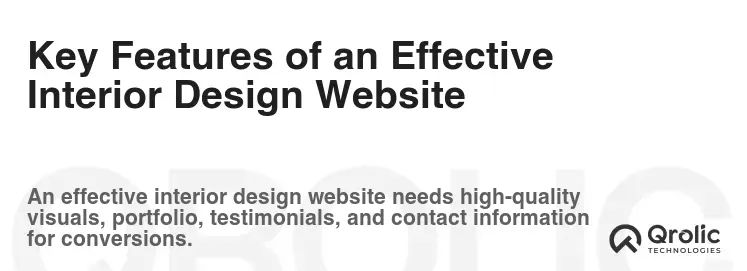
Now that you understand the “why,” let’s dive into the “what.” What elements make up a truly effective website for an interior design firm? It’s more than just pretty pictures; it’s a strategic blend of design, functionality, and marketing.
1. A Visually Stunning and User-Friendly Design
This is the foundation of any successful interior design website. It needs to be aesthetically pleasing, easy to navigate, and reflective of your brand’s identity.
- Clean and Modern Aesthetic: Avoid clutter and embrace a clean, modern design. Use white space effectively to create a sense of elegance and sophistication.
- Intuitive Navigation: Make it easy for visitors to find what they’re looking for. Use clear and concise navigation menus, breadcrumbs, and a search function.
- Mobile-Responsive Design: Ensure your website looks and functions flawlessly on all devices, from desktops to smartphones.
- High-Quality Visuals: Use professional photography and videography to showcase your projects. Ensure that images are optimized for the web to minimize loading times.
- Brand Consistency: Maintain a consistent brand identity throughout your website, including your logo, color palette, typography, and tone of voice.
2. A Compelling Portfolio
Your portfolio is your most valuable asset. It’s where you showcase your best work and demonstrate your unique design style.
- Categorized Projects: Organize your portfolio into categories based on style, room, or service. This will make it easier for visitors to find projects that match their interests.
- Detailed Project Descriptions: Provide detailed descriptions of each project, including the client’s needs, your design approach, and the results achieved.
- Before-and-After Comparisons: Showcase your transformative abilities by including before-and-after photos of your projects.
- Client Testimonials: Include testimonials from satisfied clients to build trust and credibility.
- High-Resolution Images: Use high-resolution images to showcase your projects in the best possible light.
3. A Strong “About Us” Section
This is where you tell your story and connect with potential clients on a personal level.
- Share Your Story: Share your background, your design philosophy, and your team’s expertise.
- Highlight Your Credentials: Showcase any awards, certifications, or professional affiliations you have received.
- Use Professional Photos: Include professional photos of your team to create a sense of personality and approachability.
- Connect with Your Audience: Write in a conversational tone and avoid jargon. Focus on how you can help potential clients achieve their design goals.
4. Clear Contact Information and Calls to Action
Make it easy for potential clients to get in touch with you and take the next step.
- Prominent Contact Information: Display your phone number, email address, and physical address (if applicable) prominently on your website.
- Contact Form: Include a contact form to allow visitors to easily submit inquiries.
- Clear Calls to Action: Use clear and concise calls to action to guide visitors towards taking action, such as “Request a Consultation,” “View Our Portfolio,” or “Contact Us.”
- Social Media Links: Include links to your social media profiles to allow visitors to connect with you on other platforms.
5. A Blog and Content Marketing Strategy
A blog allows you to share your expertise, attract new visitors, and establish yourself as an authority in the industry.
- Valuable Content: Create valuable content that addresses the needs and interests of your target audience.
- Design Tips and Trends: Share design tips, trend updates, and project spotlights.
- SEO Optimization: Optimize your blog posts for relevant keywords to improve your search engine rankings. Keywords like “interior design website development,” “decor web design,” and “design firm website design” are vital.
- Consistent Posting Schedule: Maintain a consistent posting schedule to keep your audience engaged and coming back for more.
6. Search Engine Optimization (SEO)
SEO is crucial for attracting organic traffic to your website and reaching potential clients who are actively searching for interior design services.
- Keyword Research: Conduct keyword research to identify the terms that your target audience is using to search for interior design services.
- On-Page Optimization: Optimize your website’s content, title tags, meta descriptions, and image alt tags for relevant keywords.
- Off-Page Optimization: Build high-quality backlinks from other reputable websites in your industry.
- Local SEO: Optimize your website for local search to attract clients in your geographic area.
- Mobile Optimization: Ensure your website is mobile-friendly, as mobile-first indexing is now a standard for search engines.
7. Fast Loading Speed and Mobile Responsiveness
These are essential for providing a seamless user experience and improving your search engine rankings.
- Optimize Images: Compress images to reduce file size without sacrificing quality.
- Leverage Browser Caching: Enable browser caching to store static resources locally and reduce loading times.
- Use a Content Delivery Network (CDN): Use a CDN to distribute your website’s content across multiple servers, reducing latency and improving loading speeds.
- Mobile-First Design: Design your website with mobile devices in mind, ensuring that it looks and functions flawlessly on all screen sizes.
8. Analytics and Tracking
Analytics allow you to track website traffic, user behavior, and conversion rates.
- Google Analytics: Use Google Analytics to track website traffic, user behavior, and conversion rates.
- Conversion Tracking: Set up conversion tracking to measure the effectiveness of your marketing campaigns.
- A/B Testing: Use A/B testing to experiment with different website elements and optimize your site for better performance.
9. Security (HTTPS)
Security is paramount. Secure your website with HTTPS to protect your visitors’ data and build trust.
- SSL Certificate: Obtain an SSL certificate from a reputable provider.
- Regular Security Audits: Conduct regular security audits to identify and address potential vulnerabilities.
- Strong Passwords: Use strong passwords for all of your website accounts.
10. Accessibility
Make your website accessible to everyone, including people with disabilities.
- Alt Text for Images: Provide descriptive alt text for all images.
- Proper Heading Structure: Use proper heading structure (H1, H2, H3, etc.) to organize your content.
- Keyboard Navigation: Ensure that your website can be navigated using a keyboard.
- Sufficient Color Contrast: Use sufficient color contrast to make your website readable for people with visual impairments.
By incorporating these key features, you can create an effective website that attracts the right clients, showcases your expertise, and helps you grow your interior design business.
The Website Development Process for Interior Design Firms: A Step-by-Step Guide
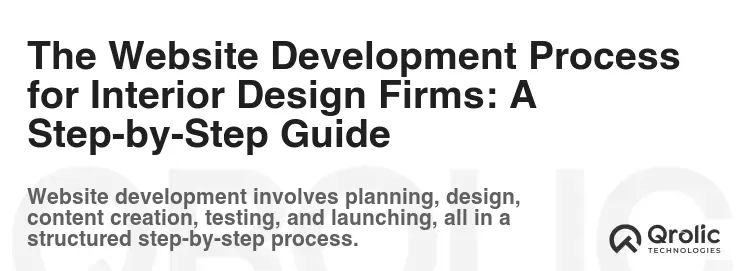
Creating a successful website is a journey, not a destination. This section outlines the key steps involved in the website development process for interior design firms.
Step 1: Planning and Strategy
This is the most crucial stage. It sets the foundation for the entire project.
- Define Your Goals: What do you want to achieve with your website? Generate leads? Showcase your portfolio? Build brand awareness?
- Identify Your Target Audience: Who are you trying to reach? What are their needs and interests?
- Competitor Analysis: Analyze your competitors’ websites. What are they doing well? What could they be doing better?
- Website Structure and Navigation: Plan the structure of your website and create a sitemap.
- Content Strategy: Develop a content strategy, including blog topics, portfolio descriptions, and about us information.
- Keyword Research: Identify the keywords you want to target for SEO. “Interior design website development”, “decor web design”, and “design firm website design” should be included.
- Budget and Timeline: Establish a budget and timeline for the project.
Step 2: Design and Development
This is where your vision comes to life.
- Wireframing and Mockups: Create wireframes and mockups to visualize the layout and design of your website.
- Design Implementation: Implement the design using HTML, CSS, and JavaScript.
- Content Creation: Write and gather all the content for your website, including text, images, and videos.
- CMS Integration: Integrate a content management system (CMS) like wordpress to allow you to easily manage your website’s content.
- Mobile Optimization: Ensure that your website is responsive and looks great on all devices.
- SEO Optimization: Optimize your website for search engines, including keyword placement, meta descriptions, and image alt tags.
Step 3: Testing and Quality Assurance
Thorough testing is essential to ensure that your website functions flawlessly.
- Cross-Browser Testing: Test your website on different browsers (Chrome, Firefox, Safari, etc.) to ensure compatibility.
- Mobile Testing: Test your website on different mobile devices and screen sizes.
- Usability Testing: Conduct usability testing to identify any issues with navigation or user experience.
- Performance Testing: Test your website’s loading speed and performance.
- Security Testing: Conduct security testing to identify any vulnerabilities.
Step 4: Launch and Deployment
It’s time to unveil your new website to the world.
- Choose a Hosting Provider: Select a reliable hosting provider that meets your website’s needs.
- Domain Name Registration: Register a domain name that reflects your brand.
- Website Deployment: Deploy your website to your hosting server.
- Website Backup: Create a backup of your website files and database.
Step 5: Marketing and Promotion
A website is only as good as the traffic it receives.
- SEO: Continue to optimize your website for search engines to improve your rankings.
- Social Media Marketing: Promote your website on social media platforms.
- Email Marketing: Build an email list and send out newsletters to promote your website.
- Content Marketing: Create valuable content to attract new visitors to your website.
- Pay-Per-Click (PPC) Advertising: Run PPC advertising campaigns to drive targeted traffic to your website.
Step 6: Maintenance and Updates
A website is not a “set it and forget it” project. Ongoing maintenance and updates are essential.
- Security Updates: Install security updates to protect your website from vulnerabilities.
- Content Updates: Keep your website content fresh and up-to-date.
- Software Updates: Update your CMS and plugins to ensure compatibility and security.
- Performance Monitoring: Monitor your website’s performance and make adjustments as needed.
- Website Backups: Regularly back up your website files and database.
The Cost of Website Development for Interior Design Firms
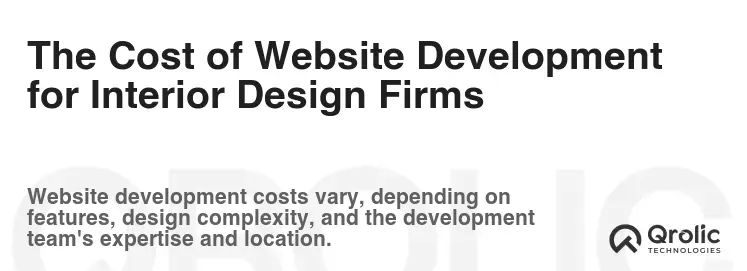
The cost of website development can vary significantly depending on the scope of the project, the features required, and the agency or freelancer you hire. Here’s a breakdown of the factors that influence the cost:
Factors Affecting Website Development Costs
- Website Complexity: A simple brochure website will cost less than a complex e-commerce website or a website with custom features.
- Design Complexity: A custom design will cost more than a template-based design.
- Content Creation: The cost of content creation will depend on the amount of content required and the expertise of the content writer.
- SEO Services: SEO services can add to the cost of website development.
- Maintenance and Support: Ongoing maintenance and support services will also add to the cost.
- Agency vs. Freelancer: Hiring a website development agency will generally cost more than hiring a freelancer.
Estimated Cost Ranges
- Simple Brochure Website: $2,000 – $5,000
- Standard Website with Portfolio and Blog: $5,000 – $15,000
- Custom Website with Advanced Features: $15,000+
Hidden Costs to Consider
- Domain Name Registration: $10 – $20 per year
- Hosting: $10 – $100 per month
- SSL Certificate: $50 – $200 per year
- Website Maintenance: $50 – $500 per month
- Marketing and Promotion: Varies
Qrolic Technologies: Your Partner in Website Development

Qrolic Technologies (https://qrolic.com/) understands the unique needs of interior design firms when it comes to website development. We offer a comprehensive range of services to help you create a stunning and effective online presence.
What Qrolic Technologies Offers:
- Custom Website Design: We create custom website designs that are tailored to your brand and target audience.
- Responsive Design: We ensure that your website looks great on all devices, from desktops to smartphones.
- SEO Optimization: We optimize your website for search engines to help you attract more organic traffic. We focus on keywords like “interior design website development”, “decor web design”, and “design firm website design” to ensure your site ranks high.
- Content Management Systems (CMS): We use user-friendly CMS platforms like WordPress to make it easy for you to manage your website content.
- E-commerce Integration: If you sell products online, we can integrate e-commerce functionality into your website.
- Website Maintenance and Support: We offer ongoing website maintenance and support services to keep your website running smoothly.
Why Choose Qrolic Technologies?
- Experience: We have years of experience in website development for interior design firms.
- Expertise: Our team of designers, developers, and SEO specialists have the expertise to create a website that meets your specific needs.
- Customer Service: We are committed to providing excellent customer service and support.
- Affordable Pricing: We offer competitive pricing to fit your budget.
- Results-Driven: We are focused on delivering results that help you grow your business.
Common Mistakes to Avoid in Interior Design Website Development
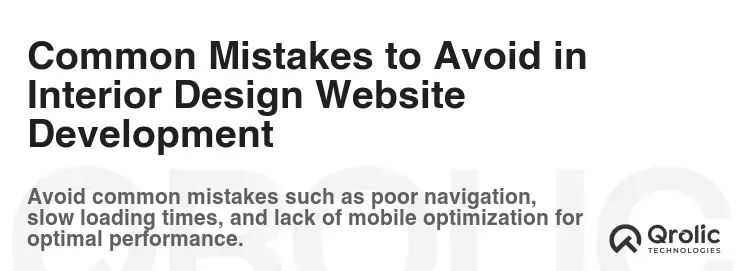
Building a website is an investment, and avoiding common pitfalls can save you time, money, and frustration. Here are some critical mistakes to steer clear of:
1. Poor Quality Photography
This is perhaps the biggest mistake. Interior design is a visual industry, and your website needs to showcase your work with stunning, professional photos.
- Amateur Photography: Avoid using amateur photography. Invest in professional photographers who specialize in interior design.
- Poor Lighting and Composition: Ensure that your photos are well-lit and composed.
- Low-Resolution Images: Use high-resolution images that are optimized for the web.
2. Cluttered Design and Poor Navigation
A cluttered design and poor navigation can frustrate visitors and drive them away from your website.
- Too Much Information: Avoid overcrowding your website with too much information.
- Difficult Navigation: Make it easy for visitors to find what they’re looking for.
- Inconsistent Design: Maintain a consistent design throughout your website.
3. Lack of Mobile Optimization
In today’s mobile-first world, a mobile-unfriendly website is a death sentence.
- Non-Responsive Design: Ensure that your website is responsive and adapts to different screen sizes.
- Slow Loading Speed on Mobile: Optimize your website for speed on mobile devices.
- Difficult to Navigate on Mobile: Make sure your website is easy to navigate on mobile devices.
4. Ignoring SEO
Failing to optimize your website for search engines will make it difficult for potential clients to find you online.
- Lack of Keyword Research: Conduct keyword research to identify the terms that your target audience is using.
- Poor On-Page Optimization: Optimize your website’s content, title tags, and meta descriptions for relevant keywords like “interior design website development,” “decor web design,” and “design firm website design.”
- Lack of Off-Page Optimization: Build high-quality backlinks from other reputable websites.
5. Not Having a Clear Call to Action
Without a clear call to action, visitors may not know what you want them to do.
- No Contact Information: Make it easy for visitors to contact you.
- No Clear Next Steps: Guide visitors towards taking action, such as requesting a consultation or viewing your portfolio.
6. Neglecting Website Security
A hacked website can damage your reputation and compromise your clients’ data.
- Lack of SSL Certificate: Secure your website with an SSL certificate.
- Outdated Software: Keep your CMS and plugins up-to-date.
- Weak Passwords: Use strong passwords for all of your website accounts.
7. Ignoring Analytics
Without analytics, you won’t know how your website is performing.
- Not Tracking Website Traffic: Use Google Analytics to track website traffic.
- Not Tracking Conversions: Set up conversion tracking to measure the effectiveness of your marketing campaigns.
8. Not Updating Content Regularly
An outdated website can make your firm look unprofessional and out of touch.
- Stale Content: Keep your website content fresh and up-to-date.
- No Blog: Create a blog to share your expertise and attract new visitors.
Future Trends in Interior Design Website Development
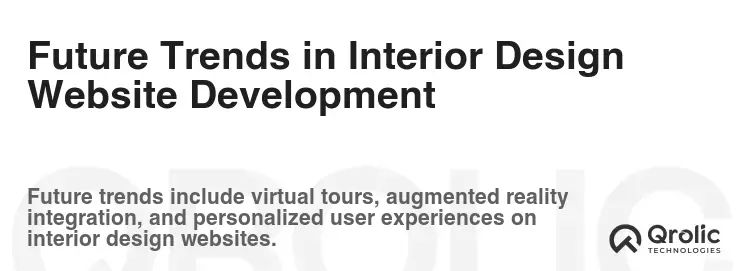
The digital landscape is constantly evolving, and interior design websites are no exception. Staying ahead of the curve is essential for maintaining a competitive edge. Here are some future trends to watch out for:
1. Augmented Reality (AR) and Virtual Reality (VR)
AR and VR technologies are transforming the way people experience interior design.
- AR Apps: Allow potential clients to visualize furniture and décor in their own homes using AR apps.
- VR Tours: Offer virtual tours of your completed projects.
2. Artificial Intelligence (AI)
AI is being used to personalize the user experience and automate tasks.
- AI-Powered Chatbots: Use AI-powered chatbots to answer frequently asked questions.
- Personalized Recommendations: Offer personalized design recommendations based on user preferences.
3. Voice Search Optimization
With the rise of voice assistants like Siri and Alexa, voice search optimization is becoming increasingly important.
- Optimize for Long-Tail Keywords: Optimize your website for long-tail keywords that people are likely to use when speaking.
- Use Natural Language: Write content that sounds natural and conversational.
4. Interactive Content
Interactive content is more engaging and can help you generate leads.
- Quizzes and Polls: Create quizzes and polls to engage your audience.
- Interactive 3D Models: Allow users to interact with 3D models of your designs.
5. Sustainability Focus
Consumers are increasingly concerned about sustainability, and interior design is no exception.
- Showcase Sustainable Materials: Highlight your use of sustainable materials and practices.
- Promote Eco-Friendly Designs: Promote eco-friendly design solutions.
By embracing these future trends, you can create a cutting-edge website that sets you apart from the competition and attracts the next generation of interior design clients. A comprehensive understanding of these details is key to “interior design website development.”






